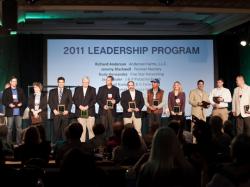American Pistachio Growers Announces Leadership Program Graduates
March 29, 2012 | 2 min to read

FRESNO, Calif. — The inaugural class of American Pistachio Growers (APG) Leadership Program completed their year-long educational and training experience and graduated at APG’s annual conference held in San Diego, in February.
The association’s program is designed to provide a highly-focused experience consisting of leadership training, seminars led by APG staff and industry leaders, hands-on educational opportunities and an in-depth view of the organization’s committee and directors’ activities to prepare participants for possible Committee and Board selection. Additionally, the program is designed to increase the overall acumen of growers and industry professionals who indicate an interest in taking a leadership role in the pistachio industry and their state’s agriculture.
The participants represented a cross section of APG’s membership, including new pistachio growers, multi-generation growers, farm managers, and representatives from processing entities. They were all from APG’s California, Arizona and New Mexico membership base.
Graduates of the 2011 class included:
- Richard Anderson, Anderson Farms, LLC
- Jeremy Blackwell, Pioneer Nursery
- Rudy Hernandez, Five Star Harvesting
- Jean Heuler, J&P Pistachio Ranch
- Anil Kumar, K&G Farms
- Adam Kusmak, Tularosa Pistachio
- Eric Montemagni, Keenan Farms, Inc.
- Tim O’Neill, O’Neill Agri-Management
- Adam Orandi, ARO Pistachio
- Sharon Roden, Roden Farms
- Larry Wilkinson, J.Poonian Ltd. Partnership
- Tristan Zannon, Santa Barbara Pistachio Ranch
In addition, participants were selected for the 2012 APG Leadership Program, including:
- Devin Aviles, Agri-World Cooperative
- Michelle Carter, Meridian Nut Growers
- Tracey Chance, Chance Ranch
- Danielle Kusmak, Tularosa Pistachio Groves
- Hamid Orandi Orandi Farms Management
- Dominic Pitigliano, Pitigliano Farms
- Donnie Rose, Jr., Kettleman Pistachio Growers
- Vahid Salehi, PIstachia Global
- Zachary Sheely, Sheely Family Farms
- Scott Shropshire, Shropshire Farms
- Matthew Watte, George Watte & Sons
- Diane Wood, Little Creek/Fiddyment Farms
About American Pistachio Growers
American Pistachio Growers is a voluntary trade association representing members who are pistachio growers, processors and industry partners in California, Arizona and New Mexico. These states represent 100% of the domestic commercial pistachio production. APG pistachios are the “Official Snack” of both USA Water Polo and Miss California. Pistachios are now one of the top four agricultural exports from California, and growing. For more information, visit www.AmericanPistachios.org.
Source: American Pistachio Growers
